Teleconnections of Atmospheric Circulations to Meteorological Drought in the Lancang-Mekong River Basin
Abstract
1. Introduction
2. Materials and Methods
2.1. Research Area
2.2. Materials and Methods
2.2.1. Meteorological Data
2.2.2. Atmospheric Circulation Indices
2.2.3. Standardized Precipitation Evapotranspiration Index
2.2.4. The Run Theory
2.2.5. Mann-Kendall Trend Test
2.2.6. Frequency of Meteorological Drought
2.2.7. Cross-Correlation Function
3. Results
3.1. Temporal Variation Characteristics of LMRB Drought
3.2. Spatial Variation Trend of LMRB Drought
3.3. Spatial Variation of Drought Trends in Dry and Wet Season
3.4. Response of the Meteorological Drought to Atmospheric Circulations
4. Discussion
5. Conclusions
- (1)
- During the research period (1980–2018), the LMRB experienced frequent dry and wet changes on a monthly and seasonal scale. November to April of the following year is a period prone to meteorological drought. Especially after 1990, the distinction between dry and wet years became more pronounced. The risk of meteorological drought events increased annually, especially in 2015 with greater intensity than in previous years, posing a significant threat to the basin.
- (2)
- The LMRB has well-defined dry and wet seasons, with the southwest monsoon bringing humidity and rainfall from May until the end of September. However, meteorological drought events continue to persist, particularly in the western region of the Khorat Plateau, the Tonle Sap Lake Basin, where a drought trend has been observed. These areas correspond to the main agricultural areas in the basin. The frequency of severe and extreme meteorological droughts during the dry season has significantly risen, particularly in the upper reaches of the Lancang River and western Khorat Plateau. In comparison to other regions, this area experiences a higher frequency of severe meteorological droughts, accounting for approximately 10% of occurrences.
- (3)
- There are differences in the response relationship between meteorological drought events in the LMRB and different atmospheric circulations (ENSO, AO, NAO, and PAO), with the strongest response being observed between the ENSO and meteorological drought events in the basin. Specifically, meteorological drought events occurring in the Northern Plateau, western parts of the Khorat Plateau, western parts of the Tonle Sap Lake Basin, and the Mekong Delta exhibit synchronicity with the ENSO. Meteorological drought events in the lower regions of the Lancang River basin show synchronicity with the AO, and there is a significant correlation between meteorological drought events in the Long Mountains and a lag of 2 months in the AO.
Author Contributions
Funding
Institutional Review Board Statement
Informed Consent Statement
Data Availability Statement
Acknowledgments
Conflicts of Interest
References
- Ayugi, B.; Tan, G.; Niu, R.; Dong, Z.; Ojara, M.; Mumo, L.; Babaousmail, H.; Ongoma, V. Evaluation of Meteorological Drought and Flood Scenarios over Kenya, East Africa. Atmosphere 2020, 11, 307. [Google Scholar] [CrossRef]
- Wang, F.; Lai, H.; Li, Y.; Feng, K.; Zhang, Z.; Tian, Q.; Zhu, X.; Yang, H. Dynamic variation of meteorological drought and its relationships with agricultural drought across China. Agric. Water Manag. 2022, 261, 107301. [Google Scholar] [CrossRef]
- Tan, Y.X.; Ng, J.L.; Huang, Y.F. Quantitative analysis of input data uncertainty for SPI and SPEI in Peninsular Malaysia based on the bootstrap method. Hydrol. Sci. J. 2023, 68, 1724–1737. [Google Scholar] [CrossRef]
- Li, Q.; Zeng, T.; Chen, Q.; Han, X.; Weng, X.; He, P.; Zhou, Z.; Du, Y. Spatio-temporal changes in daily extreme precipitation for the Lancang–Mekong River Basin. Nat. Hazards 2022, 115, 641–672. [Google Scholar] [CrossRef]
- Lehner, B.; Döll, P.; Alcamo, J.; Henrichs, T.; Kaspar, F. Estimating the Impact of Global Change on Flood and Drought Risks in Europe: A Continental, Integrated Analysis. Clim. Chang. 2006, 75, 273–299. [Google Scholar] [CrossRef]
- Stagge, J.H.; Kohn, I.; Tallaksen, L.M.; Stahl, K. Modeling drought impact occurrence based on meteorological drought indices in Europe. J. Hydrol. 2015, 530, 37–50. [Google Scholar] [CrossRef]
- Luo, X.; Luo, X.; Ji, X.; Ming, W.; Wang, L.; Xiao, X.; Xu, J.; Liu, Y.; Li, Y. Meteorological and hydrological droughts in the Lancang-Mekong River Basin: Spatiotemporal patterns and propagation. Atmos. Res. 2023, 293, 106913. [Google Scholar] [CrossRef]
- Hao, Z.; Singh, V.P. Drought characterization from a multivariate perspective: A review. J. Hydrol. 2015, 527, 668–678. [Google Scholar] [CrossRef]
- Won, J.; Choi, J.; Lee, O.; Kim, S. Copula-based Joint Drought Index using SPI and EDDI and its application to climate change. Sci. Total Environ. 2020, 744, 140701. [Google Scholar] [CrossRef]
- Zhao, H.; Gao, G.; An, W.; Zou, X.; Li, H.; Hou, M. Timescale differences between SC-PDSI and SPEI for drought monitoring in China. Phys. Chem. Earth Parts A/B/C 2017, 102, 48–58. [Google Scholar] [CrossRef]
- Stagge, J.H.; Tallaksen, L.M.; Gudmundsson, L.; Van Loon, A.F.; Stahl, K. Candidate Distributions for Climatological Drought Indices (SPI and SPEI). Int. J. Climatol. 2015, 35, 4027–4040. [Google Scholar] [CrossRef]
- Spinoni, J.; Barbosa, P.; De Jager, A.; McCormick, N.; Naumann, G.; Vogt, J.V.; Magni, D.; Masante, D.; Mazzeschi, M. A new global database of meteorological drought events from 1951 to 2016. J. Hydrol. Reg. Stud. 2019, 22, 100593. [Google Scholar] [CrossRef] [PubMed]
- Ling, M.; Han, H.; Hu, X.; Xia, Q.; Guo, X. Drought characteristics and causes during summer maize growth period on Huang-Huai-Hai Plain based on daily scale SPEI. Agric. Water Manag. 2023, 280, 108198. [Google Scholar] [CrossRef]
- Li, L.; She, D.; Zheng, H.; Lin, P.; Yang, Z.-L. Elucidating Diverse Drought Characteristics from Two Meteorological Drought Indices (SPI and SPEI) in China. J. Hydrometeorol. 2020, 21, 1513–1530. [Google Scholar] [CrossRef]
- Mohammed, S.; Alsafadi, K.; Enaruvbe, G.O.; Bashir, B.; Elbeltagi, A.; Szeles, A.; Alsalman, A.; Harsanyi, E. Assessing the impacts of agricultural drought (SPI/SPEI) on maize and wheat yields across Hungary. Sci. Rep. 2022, 12, 8838. [Google Scholar] [CrossRef] [PubMed]
- Manzano, A.; Clemente, M.A.; Morata, A.; Luna, M.Y.; Beguería, S.; Vicente-Serrano, S.M.; Martín, M.L. Analysis of the atmospheric circulation pattern effects over SPEI drought index in Spain. Atmos. Res. 2019, 230, 104630. [Google Scholar] [CrossRef]
- Wang, W.; Zhu, Y.; Xu, R.; Liu, J. Drought severity change in China during 1961–2012 indicated by SPI and SPEI. Nat. Hazards 2014, 75, 2437–2451. [Google Scholar] [CrossRef]
- Meque, A.; Abiodun, B.J. Simulating the link between ENSO and summer drought in Southern Africa using regional climate models. Clim. Dyn. 2014, 44, 1881–1900. [Google Scholar] [CrossRef]
- Zhou, L.; Wang, S.; Du, M.; Chen, Q.; He, C.; Zhang, J.; Zhu, Y.; Gong, Y. The Influence of ENSO and MJO on Drought in Different Ecological Geographic Regions in China. Remote Sens. 2021, 13, 875. [Google Scholar] [CrossRef]
- Chandrasekara, S.S.K.; Kwon, H.-H.; Vithanage, M.; Obeysekera, J.; Kim, T.-W. Drought in South Asia: A Review of Drought Assessment and Prediction in South Asian Countries. Atmosphere 2021, 12, 369. [Google Scholar] [CrossRef]
- Xing, Z.; Yu, Z.; Wei, J.; Zhang, X.; Ma, M.; Yi, P.; Ju, Q.; Wang, J.; Laux, P.; Kunstmann, H. Lagged influence of ENSO regimes on droughts over the Poyang Lake basin, China. Atmos. Res. 2022, 275, 106218. [Google Scholar] [CrossRef]
- Rezaei, A. Ocean-atmosphere circulation controls on integrated meteorological and agricultural drought over Iran. J. Hydrol. 2021, 603, 126928. [Google Scholar] [CrossRef]
- Li, X.; Sha, J.; Wang, Z.-L. Influence of the Three Gorges Reservoir on climate drought in the Yangtze River Basin. Environ. Sci. Pollut. Res. 2021, 28, 29755–29772. [Google Scholar] [CrossRef] [PubMed]
- Lv, A.; Fan, L.; Zhang, W. Impact of ENSO Events on Droughts in China. Atmosphere 2022, 13, 1764. [Google Scholar] [CrossRef]
- Zhang, B.; Li, Y.; Zhang, C.; Hu, C.; Fu, G.; Cai, X. Dual water-electricity cooperation improves economic benefits and water equality in the Lancang-Mekong River Basin. Nat. Commun. 2023, 14, 6228. [Google Scholar] [CrossRef] [PubMed]
- Vicente-Serrano, S.M.; Beguería, S.; López-Moreno, J.I. A Multiscalar Drought Index Sensitive to Global Warming: The Standardized Precipitation Evapotranspiration Index. J. Clim. 2010, 23, 1696–1718. [Google Scholar] [CrossRef]
- Sun, C.; Xiao, Z.-N.; Nguyen, M. Projection on precipitation frequency of different intensities and precipitation amount in the Lancang-Mekong River basin in the 21st century. Adv. Clim. Chang. Res. 2021, 12, 162–171. [Google Scholar] [CrossRef]
- Do, P.; Tian, F.; Zhu, T.; Zohidov, B.; Ni, G.; Lu, H.; Liu, H. Exploring synergies in the water-food-energy nexus by using an integrated hydro-economic optimization model for the Lancang-Mekong River basin. Sci. Total Environ. 2020, 728, 137996. [Google Scholar] [CrossRef]
- Luo, X.; Wang, Y.; Li, Y. Responses of ecosystem water use efficiency to drought in the Lancang–Mekong River Basin. Front. Ecol. Evol. 2023, 11, 1203725. [Google Scholar] [CrossRef]
- Ty, T.V.; Lavane, K.; Nguyen, P.C.; Downes, N.K.; Nam, N.D.G.; Minh, H.V.T.; Kumar, P. Assessment of Relationship between Climate Change, Drought, and Land Use and Land Cover Changes in a Semi-Mountainous Area of the Vietnamese Mekong Delta. Land 2022, 11, 2175. [Google Scholar] [CrossRef]
- Kang, H.; Sridhar, V.; Ali, S.A. Climate change impacts on conventional and flash droughts in the Mekong River Basin. Sci. Total Environ. 2022, 838, 155845. [Google Scholar] [CrossRef]
- Ming, W.; Luo, X.; Luo, X.; Long, Y.; Xiao, X.; Ji, X.; Li, Y. Quantitative Assessment of Cropland Exposure to Agricultural Drought in the Greater Mekong Subregion. Remote Sens. 2023, 15, 2737. [Google Scholar] [CrossRef]
- Han, X.; Li, Q.; Yang, X.; Xu, S.; Zou, Z.; Deng, M.; Wang, W. The influence of anthropogenic climate change on meteorological drought in the Lancang-Mekong River basin. J. Hydrol. 2023, 626, 130334. [Google Scholar] [CrossRef]
- Wang, S.; Zhang, L.; She, D.; Wang, G.; Zhang, Q. Future projections of flooding characteristics in the Lancang-Mekong River Basin under climate change. J. Hydrol. 2021, 602, 126778. [Google Scholar] [CrossRef]
- Ullah, S.; You, Q.; Sachindra, D.A.; Nowosad, M.; Ullah, W.; Bhatti, A.S.; Jin, Z.; Ali, A. Spatiotemporal changes in global aridity in terms of multiple aridity indices: An assessment based on the CRU data. Atmos. Res. 2022, 268, 105998. [Google Scholar] [CrossRef]
- Beguería, S.; Vicente-Serrano, S.M.; Reig, F.; Latorre, B. Standardized precipitation evapotranspiration index (SPEI) revisited: Parameter fitting, evapotranspiration models, tools, datasets and drought monitoring. Int. J. Climatol. 2014, 34, 3001–3023. [Google Scholar] [CrossRef]
- Vicente-Serrano, S.M.; López-Moreno, J.I.; Gimeno, L.; Nieto, R.; Morán-Tejeda, E.; Lorenzo-Lacruz, J.; Beguería, S.; Azorin-Molina, C. A multiscalar global evaluation of the impact of ENSO on droughts. J. Geophys. Res. 2011, 23, 1696. [Google Scholar] [CrossRef]
- Luo, N.; Mao, D.; Wen, B.; Liu, X. Climate Change Affected Vegetation Dynamics in the Northern Xinjiang of China: Evaluation by SPEI and NDVI. Land 2020, 9, 90. [Google Scholar] [CrossRef]
- Wu, R.; Zhang, J.; Bao, Y.; Guo, E. Run Theory and Copula-Based Drought Risk Analysis for Songnen Grassland in Northeastern China. Sustainability 2019, 11, 6032. [Google Scholar] [CrossRef]
- Pei, Z.; Fang, S.; Wang, L.; Yang, W. Comparative Analysis of Drought Indicated by the SPI and SPEI at Various Timescales in Inner Mongolia, China. Water 2020, 12, 1925. [Google Scholar] [CrossRef]
- Moradi, H.R.; Rajabi, M.; Faragzadeh, M. Investigation of meteorological drought characteristics in Fars province, Iran. Catena 2011, 84, 35–46. [Google Scholar] [CrossRef]
- Senatilleke, U.; Sirisena, J.; Gunathilake, M.B.; Muttil, N.; Rathnayake, U. Monitoring the Meteorological and Hydrological Droughts in the Largest River Basin (Mahaweli River) in Sri Lanka. Climate 2023, 11, 57. [Google Scholar] [CrossRef]
- Cao, S.; Zhang, L.; He, Y.; Zhang, Y.; Chen, Y.; Yao, S.; Yang, W.; Sun, Q. Effects and contributions of meteorological drought on agricultural drought under different climatic zones and vegetation types in Northwest China. Sci. Total Environ. 2022, 821, 153270. [Google Scholar] [CrossRef] [PubMed]
- Sharma, A.; Goyal, M.K. Assessment of drought trend and variability in India using wavelet transform. Hydrol. Sci. J. 2020, 65, 1539–1554. [Google Scholar] [CrossRef]
- Kingston, D.G.; Stagge, J.H.; Tallaksen, L.M.; Hannah, D.M. European-Scale Drought: Understanding Connections between Atmospheric Circulation and Meteorological Drought Indices. J. Clim. 2015, 28, 505–516. [Google Scholar] [CrossRef]
- Rahmani, F.; Fattahi, M.H. A multifractal cross-correlation investigation into sensitivity and dependence of meteorological and hydrological droughts on precipitation and temperature. Nat. Hazards 2021, 109, 2197–2219. [Google Scholar] [CrossRef]
- Zhang, R.; Chen, Z.Y.; Xu, L.J.; Ou, C.Q. Meteorological drought forecasting based on a statistical model with machine learning techniques in Shaanxi province, China. Sci. Total Environ. 2019, 665, 338–346. [Google Scholar] [CrossRef]
- Dong, Z.; Liu, H.; Baiyinbaoligao; Hu, H.; Khan, M.Y.A.; Wen, J.; Chen, L.; Tian, F. Future projection of seasonal drought characteristics using CMIP6 in the Lancang-Mekong River Basin. J. Hydrol. 2022, 610, 127815. [Google Scholar] [CrossRef]
- Yun, X.; Tang, Q.; Li, J.; Lu, H.; Zhang, L.; Chen, D. Can reservoir regulation mitigate future climate change induced hydrological extremes in the Lancang-Mekong River Basin? Sci. Total Environ. 2021, 785, 147322. [Google Scholar] [CrossRef]
- Li, D.; Zhao, J.; Govindaraju, R.S. Water benefits sharing under transboundary cooperation in the Lancang-Mekong River Basin. J. Hydrol. 2019, 577, 123989. [Google Scholar] [CrossRef]
- Minh, H.V.T.; Lavane, K.; Ty, T.V.; Downes, N.K.; Hong, T.T.K.; Kumar, P. Evaluation of the Impact of Drought and Saline Water Intrusion on Rice Yields in the Mekong Delta, Vietnam. Water 2022, 14, 3499. [Google Scholar] [CrossRef]
- Nguyen, T.T.; Li, M.H.; Vu, T.M.; Chen, P.Y. Multiple drought indices and their teleconnections with ENSO in various spatiotemporal scales over the Mekong River Basin. Sci. Total Environ. 2023, 854, 158589. [Google Scholar] [CrossRef]
- Zhang, Y.; Hao, Z.; Feng, S.; Zhang, X.; Xu, Y.; Hao, F. Agricultural drought prediction in China based on drought propagation and large-scale drivers. Agric. Water Manag. 2021, 255, 107028. [Google Scholar] [CrossRef]
- Feng, P.; Wang, B.; Luo, J.J.; Liu, L.; Waters, C.; Ji, F.; Ruan, H.; Xiao, D.; Shi, L.; Yu, Q. Using large-scale climate drivers to forecast meteorological drought condition in growing season across the Australian wheatbelt. Sci. Total Environ. 2020, 724, 138162. [Google Scholar] [CrossRef] [PubMed]
- Venkatappa, M.; Sasaki, N.; Han, P.; Abe, I. Impacts of droughts and floods on croplands and crop production in Southeast Asia—An application of Google Earth Engine. Sci. Total Environ. 2021, 795, 148829. [Google Scholar] [CrossRef] [PubMed]
- Minh, H.V.T.; Van Ty, T.; Avtar, R.; Kumar, P.; Le, K.N.; Ngan, N.V.C.; Khanh, L.H.; Nguyen, N.C.; Downes, N.K. Implications of climate change and drought on water requirements in a semi-mountainous region of the Vietnamese Mekong Delta. Environ. Monit. Assess. 2022, 194, 766. [Google Scholar] [CrossRef] [PubMed]
- Liu, J.; Chen, D.; Mao, G.; Irannezhad, M.; Pokhrel, Y. Past and Future Changes in Climate and Water Resources in the Lancang–Mekong River Basin: Current Understanding and Future Research Directions. Engineering 2022, 13, 144–152. [Google Scholar] [CrossRef]
- Zhang, L.; Song, W.; Song, W. Assessment of Agricultural Drought Risk in the Lancang-Mekong Region, South East Asia. Int. J. Environ. Res. Public Health 2020, 17, 6153. [Google Scholar] [CrossRef] [PubMed]
- Lavane, K.; Kumar, P.; Meraj, G.; Han, T.G.; Ngan, L.H.B.; Lien, B.T.B.; Van Ty, T.; Thanh, N.T.; Downes, N.K.; Nam, N.D.G.; et al. Assessing the Effects of Drought on Rice Yields in the Mekong Delta. Climate 2023, 11, 13. [Google Scholar] [CrossRef]

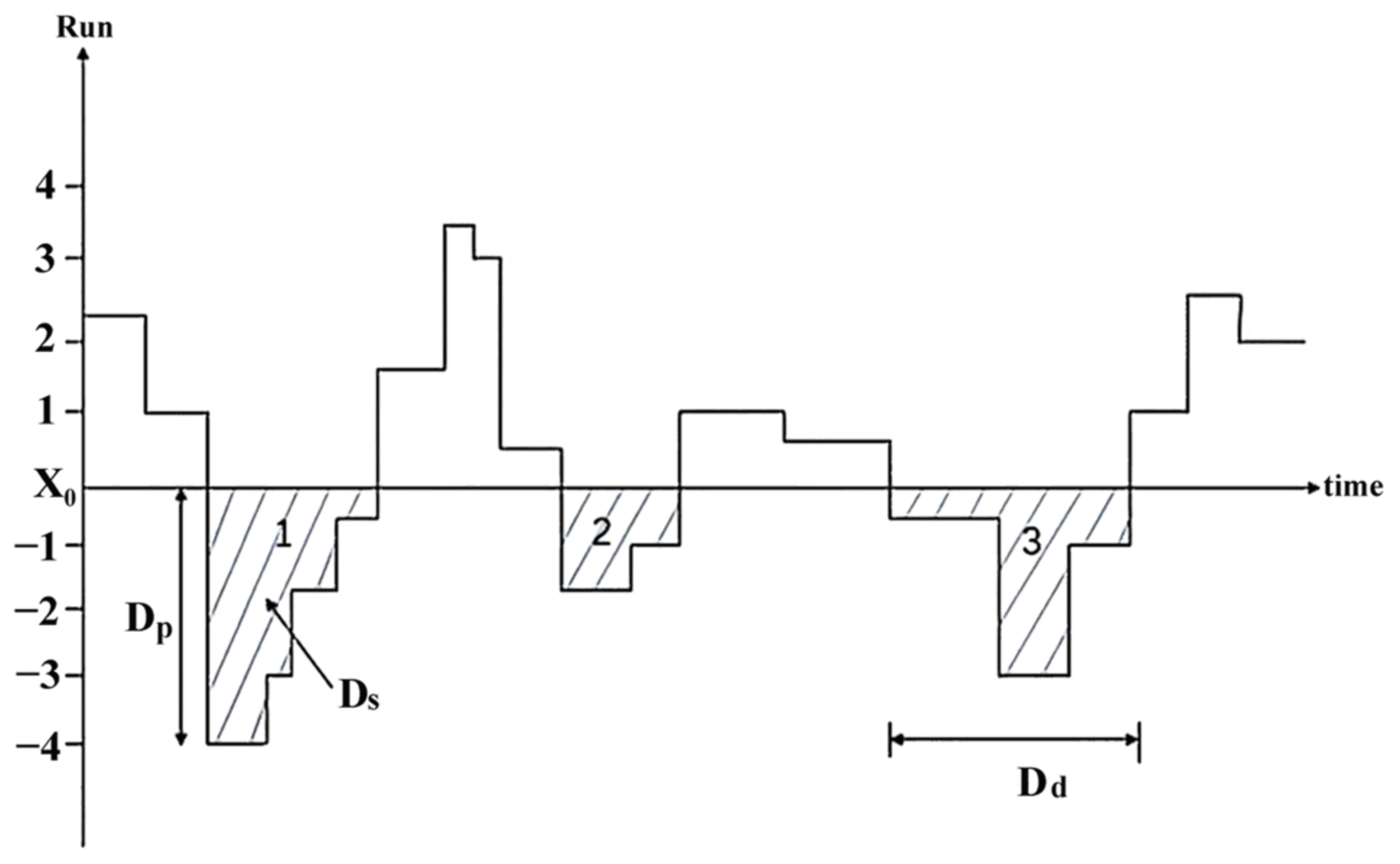
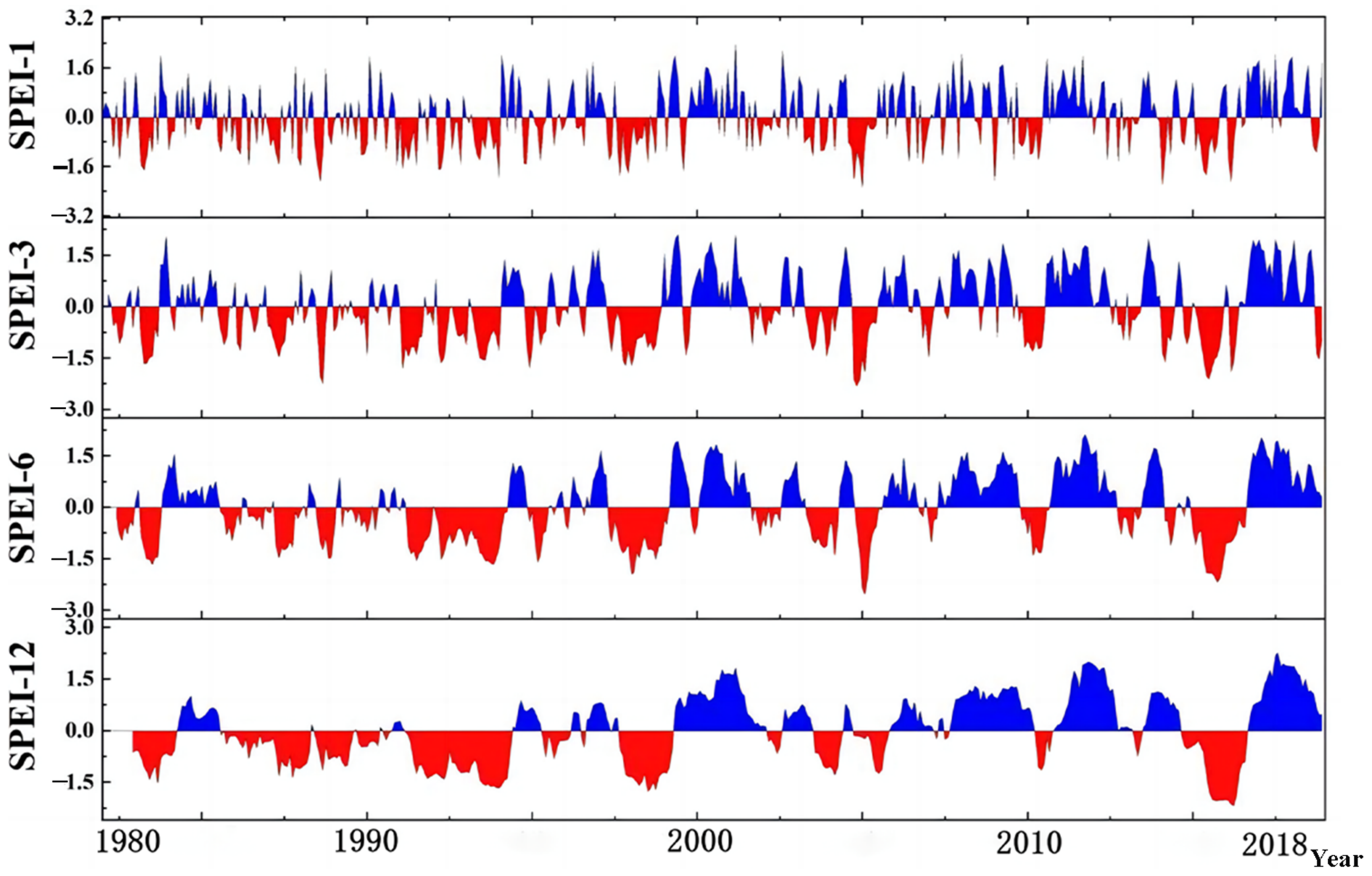
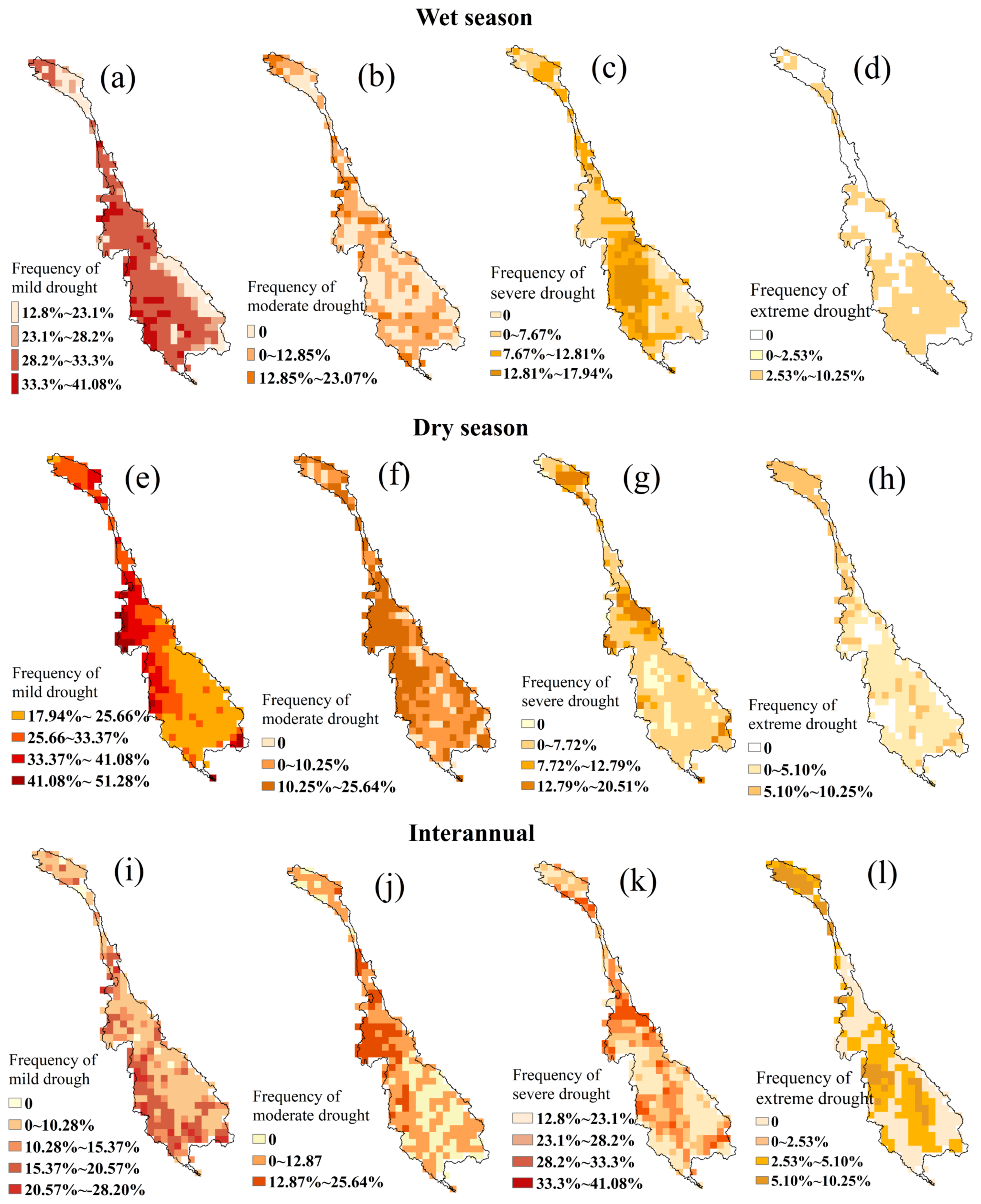
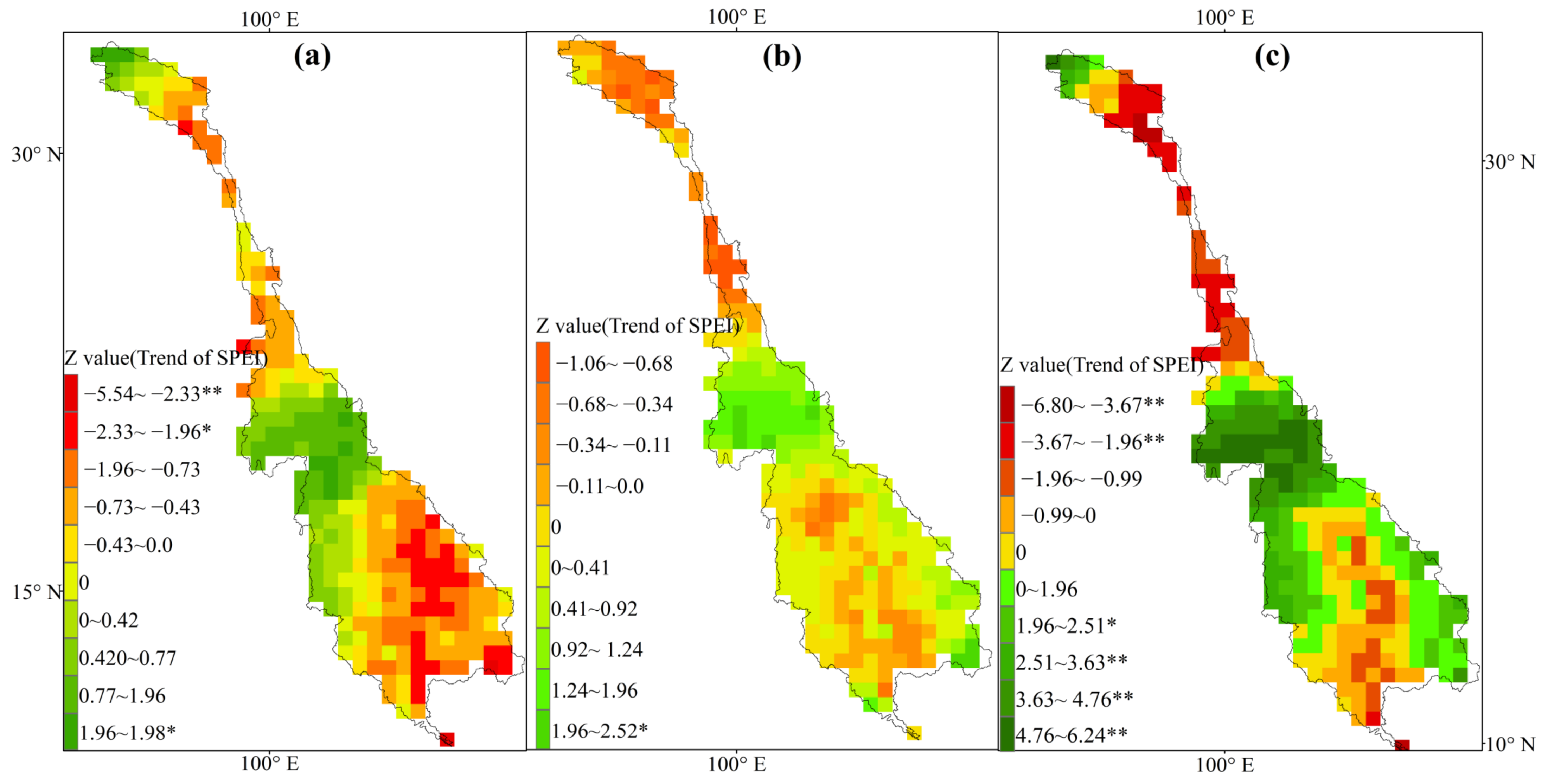
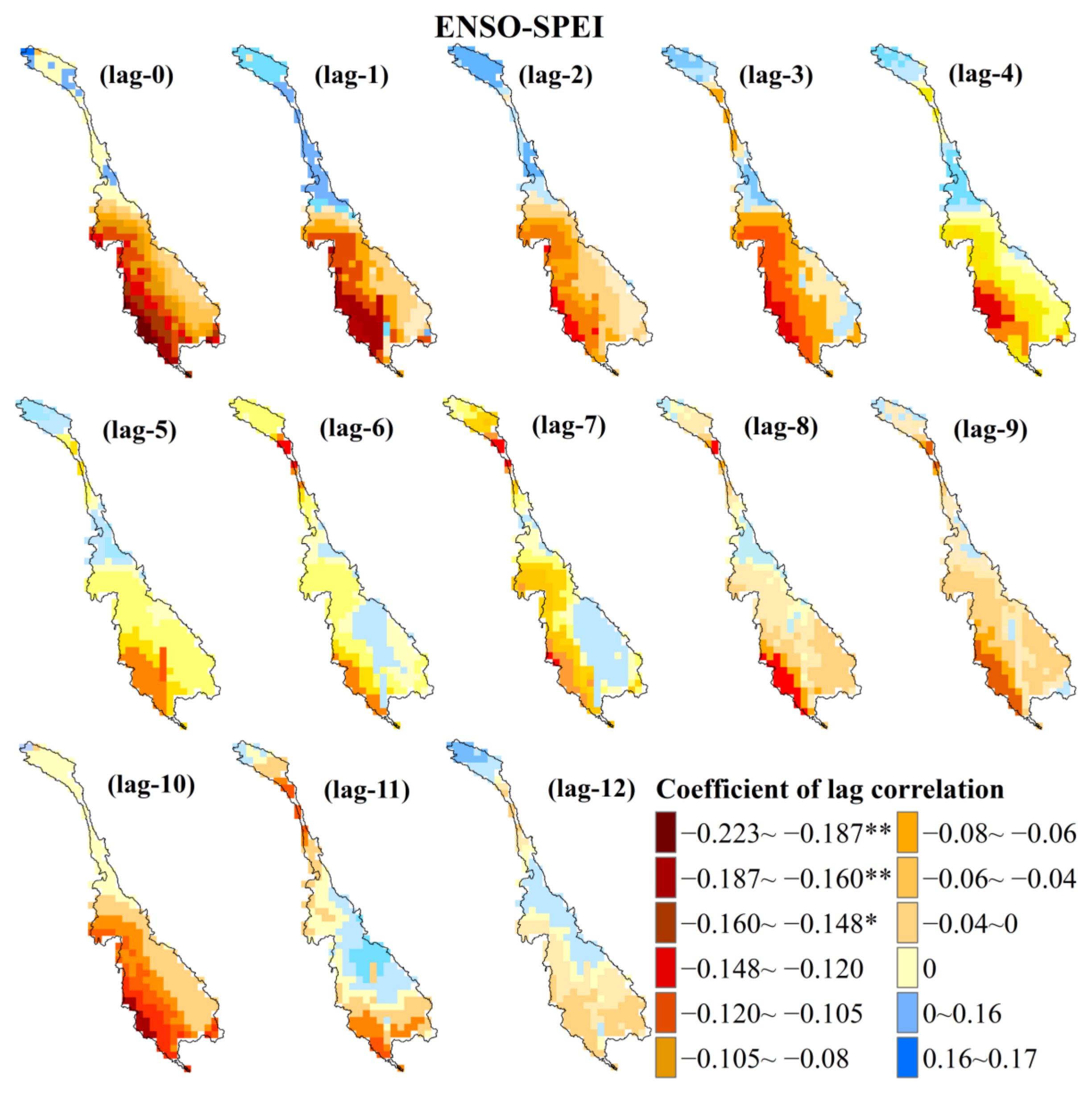
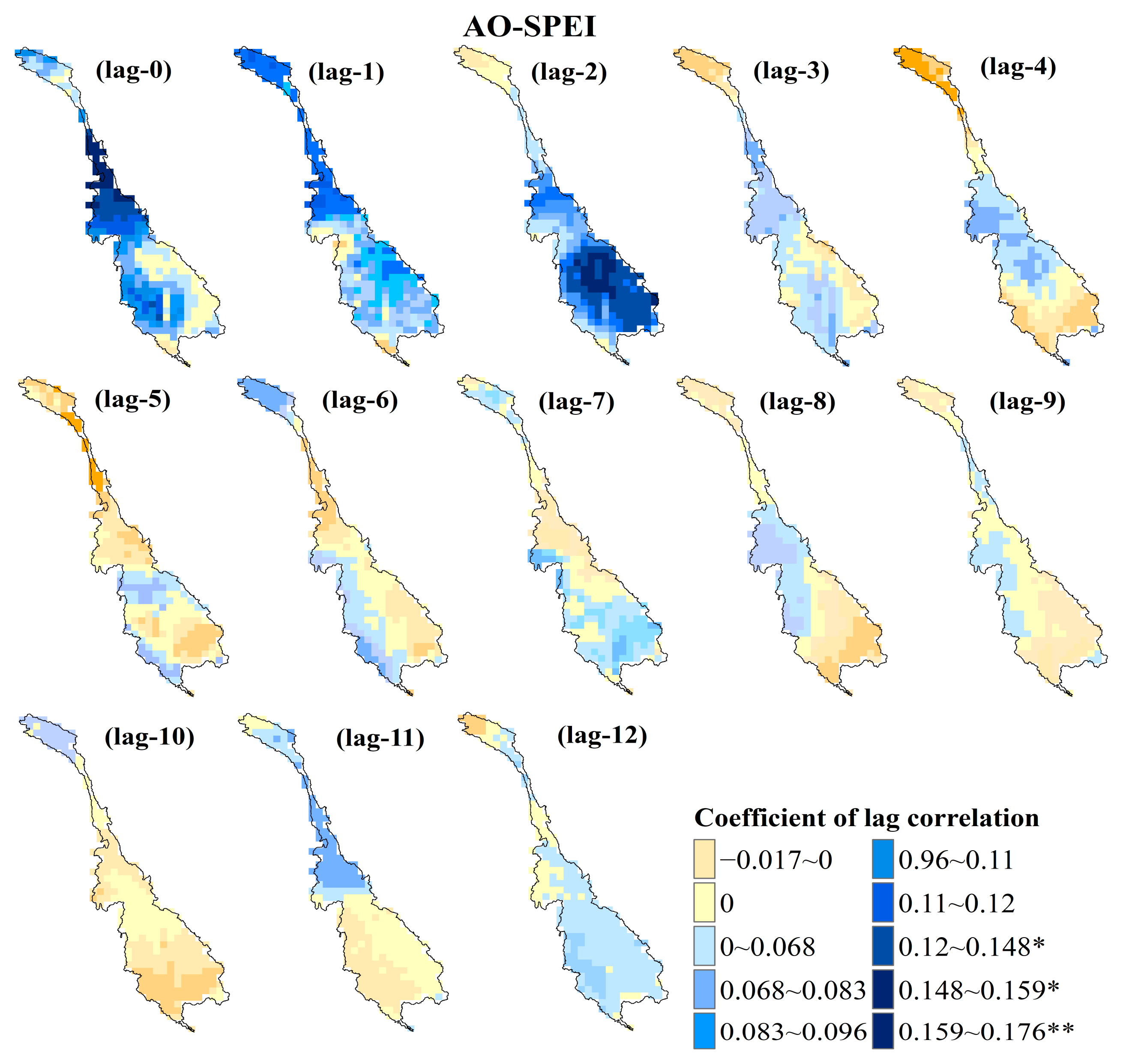

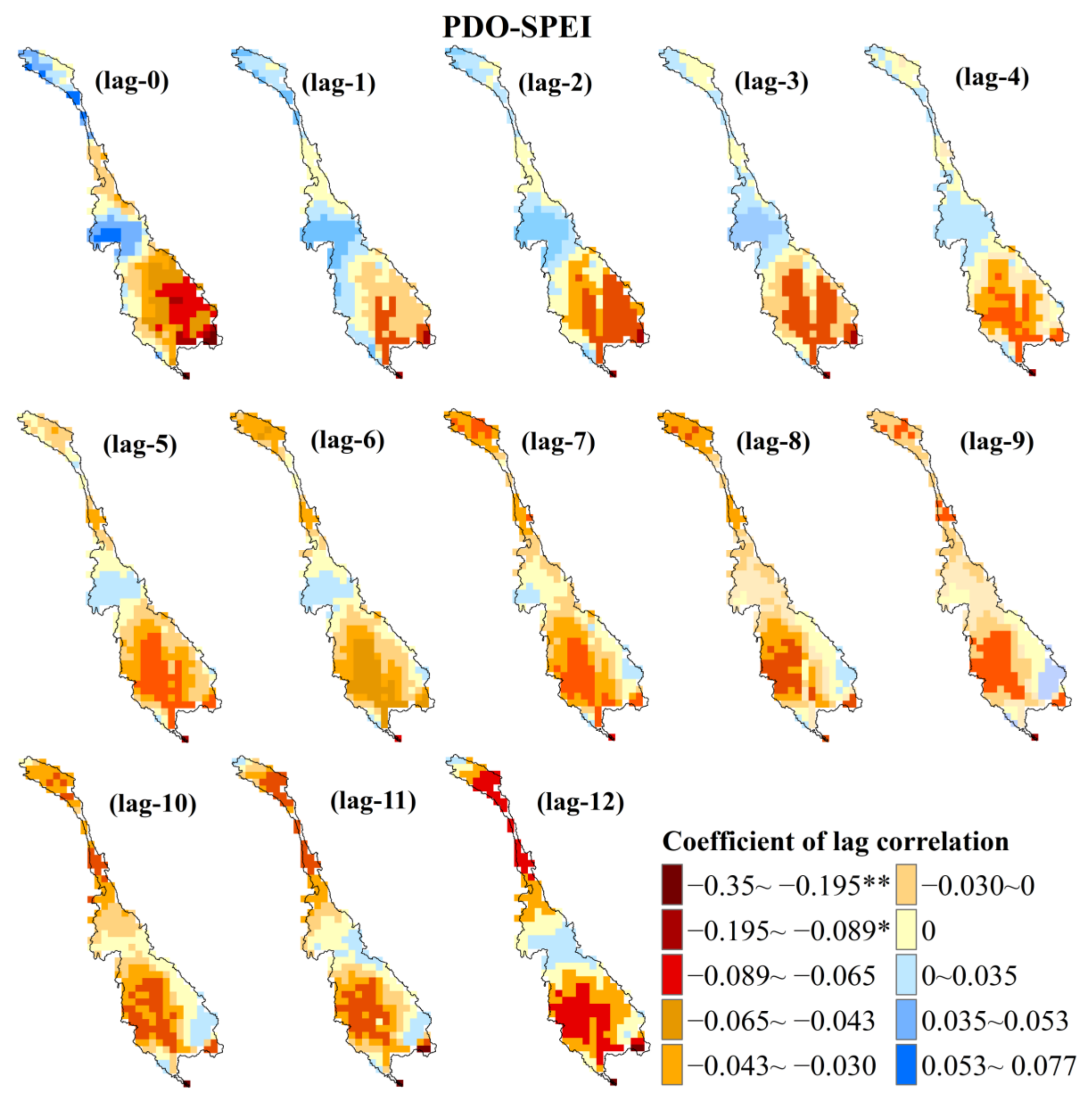
| Method | Data Type | R | MAE | RMSE |
|---|---|---|---|---|
| Distance weighted interpolation | Temperature | 0.756 | 8.21 | 10.56 |
| Precipitation | 0.864 | 6.34 | 7.69 | |
| The bilinear interpolation | Temperature | 0.951 | 2.32 | 4.82 |
| Precipitation | 0.935 | 3.03 | 4.18 |
| NO | Atmospheric Circulation | ID | Data Source |
|---|---|---|---|
| 1 | EI Nino-Southern Oscillation | ENSO | NOAA Physical Sciences Division (PSD) |
| 2 | North Atlantic Oscillation | NAO | NOAA Climate Prediction Centre (CPC) |
| 3 | Arctic Oscillation | AO | NOAA Physical Sciences Division (PSD) |
| 4 | Pacific Decadal Oscillation | PDO | National Centre for Atmospheric Research (NCAR) |
| Level | Type | SPEI Value |
|---|---|---|
| 1 | Normal/Wetness | −0.5 < SPEI |
| 2 | Mild drought | −1.0 < SPEI ≤ −0.5 |
| 3 | Moderate drought | −1.5 < SPEI ≤ −1.0 |
| 4 | Severe drought | −2.0 < SPEI ≤ −1.5 |
| 5 | Extreme drought | SPEI ≤ −2.0 |
| Time Scale | Number of Events | Average Duration | Average Severity | Average Intensity |
|---|---|---|---|---|
| 1 | 82 | 6 | 4.57 | 1.33 |
| 3 | 50 | 10 | 8.06 | 1.43 |
| 6 | 29 | 13 | 10.45 | 1.67 |
| 12 | 17 | 18 | 13.56 | 1.45 |
| Type | Time | China | Myanmar | Laos | Thailand | Cambodia | Vietnam |
|---|---|---|---|---|---|---|---|
| Basin area (104 km2) | / | 16.5 | 2.4 | 20.2 | 18.4 | 15.5 | 6.5 |
| average water yield (m3/s) | / | 2410 | 300 | 5270 | 2560 | 2860 | 1660 |
| Irrigated area (104 hm2) | / | 42 | — | 70 | 50 | 58 | 240 |
| Irrigation water consumption (108 m3) | Dry season | 20.48 | — | 34.4 | 63.23 | 79.59 | 193.75 |
| Rainy season | 5.12 | — | 11.47 | 94.84 | 34.11 | 68.07 |
Disclaimer/Publisher’s Note: The statements, opinions and data contained in all publications are solely those of the individual author(s) and contributor(s) and not of MDPI and/or the editor(s). MDPI and/or the editor(s) disclaim responsibility for any injury to people or property resulting from any ideas, methods, instructions or products referred to in the content. |
© 2024 by the authors. Licensee MDPI, Basel, Switzerland. This article is an open access article distributed under the terms and conditions of the Creative Commons Attribution (CC BY) license (https://creativecommons.org/licenses/by/4.0/).
Share and Cite
Fan, L.; Wang, Y.; Cao, C.; Chen, W. Teleconnections of Atmospheric Circulations to Meteorological Drought in the Lancang-Mekong River Basin. Atmosphere 2024, 15, 89. https://doi.org/10.3390/atmos15010089
Fan L, Wang Y, Cao C, Chen W. Teleconnections of Atmospheric Circulations to Meteorological Drought in the Lancang-Mekong River Basin. Atmosphere. 2024; 15(1):89. https://doi.org/10.3390/atmos15010089
Chicago/Turabian StyleFan, Lei, Yi Wang, Chenglin Cao, and Wen Chen. 2024. "Teleconnections of Atmospheric Circulations to Meteorological Drought in the Lancang-Mekong River Basin" Atmosphere 15, no. 1: 89. https://doi.org/10.3390/atmos15010089
APA StyleFan, L., Wang, Y., Cao, C., & Chen, W. (2024). Teleconnections of Atmospheric Circulations to Meteorological Drought in the Lancang-Mekong River Basin. Atmosphere, 15(1), 89. https://doi.org/10.3390/atmos15010089






